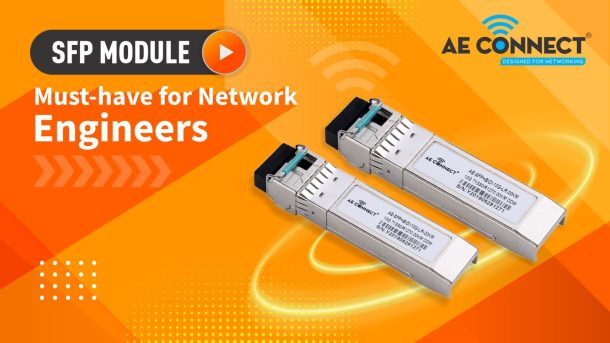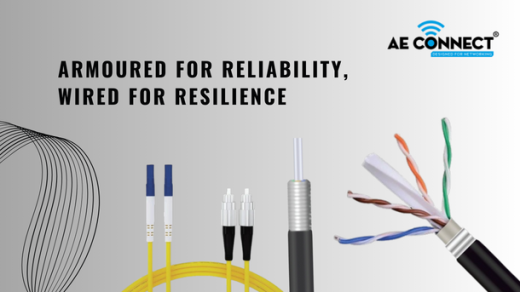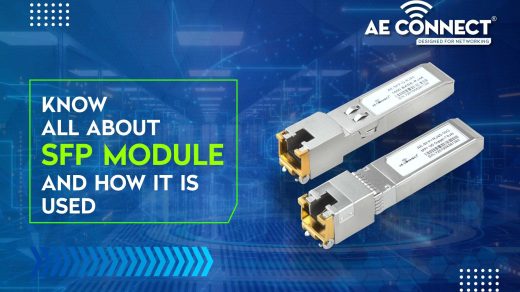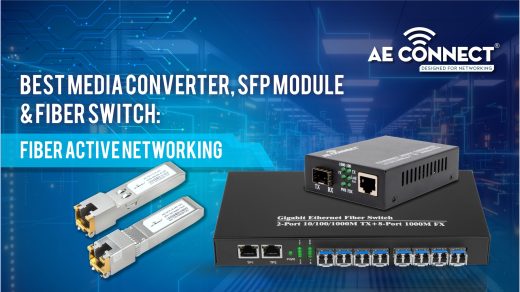Living in the ever-evolving scene of networking advancement, standing ahead of the loop is critical for network engineers and IT professionals. The lone important component that frequently makes its way into their toolkit is the SFP module. Small-sized yet highly potent, these compact devices play a huge part in the connectivity and efficiency of modern networks.
For almost two decades, we at AE Connect have witnessed the evolution of this tiny, indispensable device, and are here to guide you through everything you need to know about SFP modules, from their basics to troubleshooting issues.
What is an SFP Module?
Let’s start with the fundamentals. SFP stands for Small Form-factor Pluggable. It’s a compact, hot-swappable transceiver used in data communication and telecommunication applications. These modules are often called mini-GBICs (Gigabit Interface Converters) due to their ability to convert electrical signals to optical or vice versa.
An SFP module resembles a small metal box with a connector on one end, making it easy to insert and remove from compatible network devices such as networking switches, routers, and network interface cards (NICs). These modules come in various types, including SFP and SFP+, each designed for specific data rates and distances.
What is the Function of the SFP Module?
The primary function of an SFP module is to enable data transmission across different types of media, including fiber optic cables and copper cables. It serves as the link between the optical and electrical domains in a network, converting digital signals into optical signals for long-distance transmission or vice versa for shorter distances.
SFP transceivers play a pivotal role in ensuring network flexibility and scalability. Network engineers can select the appropriate SFP module type based on their specific needs, allowing them to customize their network infrastructure.
How Do You Choose the Right SFP Module?
Selecting the right SFP module is critical to ensure optimal network performance. Here are some key factors to consider:
Data Rate:
Determine the required data rate for your network. SFP modules come in various speeds, from 100Mbps to 100Gbps.
Distance:
Keep in view the distance over which you need to pass on data. Distinct SFP modules are developed for short-range, intermediate-range, and long-range applications.
Fiber Type:
Choose the appropriate SFP module depending on whether you’re working with single-mode (for long distances) or multi-mode (for short distances) fiber optic cable.
Compatibility:
Make sure your networking hardware is compatible with the SFP module. Not all modules work with all devices, so check compatibility lists provided by manufacturers.
Is SFP Better than RJ45?
This one is a popular question in the networking field. SFP and RJ45 are two different innovations, each with its own strengths.
SFP modules are generally preferred for:
- Long-distance, high-speed connections.
- Fiber optic networks.
- Scalable and flexible network designs.
On the other hand, RJ45 (Ethernet) is preferred for:
- Shorter-distance connections within a building.
- Cost-effective solutions.
- Compatibility with existing infrastructure.
The choice between SFP and RJ45 depends on your network’s specific requirements and your budget.
What are the Components of the SFP Module?
Inside the seemingly unassuming SFP module, you’ll find a complex set of components working together to facilitate data transmission. The key components include:
Transmitter: This element converts electrical signals into optical signals for transmission.
Receiver: It receives incoming optical signals and converts them back into electrical signals.
Microcontroller: This controls and monitors the module’s functions, ensuring optimal performance.
LC Connector: This modest, latching connector is put to use to connect the SFP module to optical fiber or copper cabling.
EEPROM: An Electrically Erasable Programmable Read-Only Memory (EEPROM) stores vital information about the module, such as manufacturer details, serial number, and compatibility data.
Diagnostic Features: Some advanced SFP modules include diagnostics and monitoring features, such as Digital Optical Monitoring (DOM) to track performance and troubleshoot issues.
What is the Input Voltage of SFP?
SFP modules typically operate on low voltage, usually around 3.3 volts. This low voltage requirement makes them energy-efficient and suitable for a wide range of network devices.
How to Troubleshoot SFP Module Issues?
Even the most reliable SFP modules can encounter issues over time. Here are some troubleshooting steps to help you diagnose and resolve common SFP module problems:
Check Physical Connections:
Ensure that the module is properly inserted into its slot and that the fiber optic cable is securely connected.
Inspect Fiber Optic Cables:
Examine the cables for damage, bends, or kinks that could affect signal transmission.
Verify Compatibility:
Confirm that the SFP module is compatible with your network equipment. Mismatched modules can lead to connectivity problems.
Use Diagnostic Tools:
Many SFP modules come with diagnostic features. Utilize these tools to monitor the module’s performance and detect issues.
Update Firmware:
Be sure that your network equipment’s firmware is updated. Manufacturers often introduce firmware upgrades that can enhance compatibility and functionality.
Replace Faulty Modules:
If all else fails, consider replacing the SFP module. Over time, these modules can wear out, leading to degraded performance.
Unlocking Connectivity: AE Connect for Reliable SFP Modules
In the dynamic sphere of networking and connectivity, the request for high-performance solutions is ever on the rise. As setups and industries continue to advance, the need for trusted, effective, and economical networking equipment has never been truly more critical.
Here is where AE Connect, your trusted companion, takes action, bridging the gap between innovation and connectivity.
At AE Connect, we take pride in being at the forefront of networking technology. With great care and commitment to superior quality and innovation, we have placed ourselves as a reputable manufacturer of Small Form-factor Pluggable (SFP) modules, providing groundbreaking solutions that empower networks all around the world.
Our SFP modules are manufactured in India, ascertaining that they satisfy the top standards of quality and reliability. We take advantage of the latest advancements in networking technology to create SFP modules that deliver solid gold performance.
Every AE Connect SFP module undergoes rigorous testing to ensure it meets or exceeds industry standards. Whether you need high-speed data transmission or long-distance connectivity, our modules are engineered to meet your specific needs.
You can trust our products to perform consistently and reliably at reasonable pricing.
Conclusion
SFP modules are vital for modern networking. When choosing one, consider the data rate, distance, fiber type, and compatibility with your devices. Inside an SFP module, multiple components work together, and they typically operate on low voltage.
Troubleshooting SFP issues involves checking connections, inspecting cables, verifying compatibility, using diagnostics, updating firmware, and replacing faulty modules. Trust AE Connect for top-quality, rigorously tested SFP modules, ensuring reliable performance for various networking requirements.




